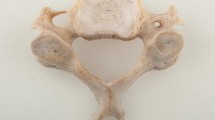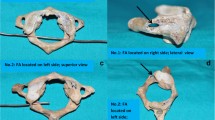Abstract
Purpose
To analyze the prevalence of the retrotransverse foramen (RTF) and its bony variations.
Methods
One hundred ten atlases of living adult subjects, 161 twentieth century dry adult cervical atlases and four dry adult cervical atlases from medieval skeletons were studied to detect the RTF and its abnormal bony variations. The 110 living adult subjects underwent a computed tomography study to detect the RTF.
Results
In the in vivo sample (n = 110; 100%), the RTF was found in four (3.6%) atlases. It was bilateral in all cases, but three (2.7%) patients showed complete RTF and the other patient presented a complete RTF in the left transverse process and an unclosed RTF in the right transverse process. In addition, the RTF was observed in combination with an unclosed transverse foramen in two cases (1.8%). In the twentieth century skeletal sample (n = 206; 100%) the RTF was found in 15 (7.3%) C1 vertebrae. It was bilateral in three (1.5%) vertebrae and unilateral in another 12 (5.8%) vertebrae. In the medieval skeletal sample (n = 4; 100%) one cadaveric atlas (25%) presented a bilateral RTF with special bony characteristics which presented an unexpected spicula in the left RTF.
Conclusions
The RTF is a nonmetric variant of the atlas vertebra that can present non-degenerative and non-traumatic spiculae or it can be unclosed. In addition, it can be associated with the presence of unclosed transverse foramina.




Similar content being viewed by others
References
Le Minor JM (1997) The retrotransverse foramen of the human atlas vertebra. A distinctive variant within primates. Acta Anat (Basel) 160:208–212
Paraskevas G, Papaziogas B, Tsonidis C, Kapetanos G (2005) Gross morphology of the bridges over the vertebral artery groove on the atlas. Surg Radiol Anat 27:129–136
Bodon G, Grimm A, Hirt B, Seifarth H, Barsa P (2016) Applied anatomy of screw placement via the posterior arch of the atlas and anatomy-based refinements of the technique. Eur J Orthop Surg Traumatol 26:793–803
Quiles-Guiñau L, Gómez-Cabrero A, Miquel-Feucht M, Aparicio A (2016) Retrotransverse foramen in atlas vertebrae of the late 17th and 18th centuries. IJAE 121:123–132
Veleanu C, Bârzu S, Pánescu S, Udroiu C (1977) Retro transverse groove or canal of atlas and its significance. Acta Anat 97:400–402
Gupta SC, Gupta CD, Arora AK, Maheshwari BB (1979) The retrotransverse groove/canal in Indian atlas vertebrae. Anat Anz 145:514–516
Bilodi AK, Gupta SC (2005) Presence of retro transverse groove or canal in atlas vertebrae. J Anat Soc India 54:16–18
Karau PB, Ogengo JA, Hassanali J, Odula P (2010) Anatomy and prevalence of atlas vertebrae bridges in a Kenyan population: an osteological study. Clin Anat 23:649–653
Travan L, Saccheri P, Gregoraci G, Mardegan C, Crivellato E (2015) Normal anatomy and anatomic variants of vascular foramens in the cervical vertebrae: a paleo-osteological study and review of the literature. Anat Sci Int 90:308–323
Paraskevas GK, Tsitsopoulos PP, Ioannidis OM (2013) Incidence and purpose of the clival canal, a “neglected” skull base canal. Acta Neurochir (Wien) 155:139–140
Elliott RE, Tanweer O (2014) The prevalence of the ponticulus posticus (arcuate foramen) and its importance in the Goel–Harms procedure: meta-analysis and review of the literature. World Neurosurg 82:E335–E343
Wight S, Osborne N, Breen AC (1999) Incidence of ponticulus posterior of the atlas in migraine and cervicogenic headache. J Manip Physiol Ther 22:15–20
Cushing KE, Ramesh V, Gardner-Medwin D, Todd NV, Gholkar A, Baxter P, Griffiths PD (2001) Tethering of the vertebral artery in the congenital arcuate foramen of the atlas vertebra: a possible cause of vertebral artery dissection in children. Dev Med Child Neurol 43:491–496
Split W, Sawrasewicz-Rybak M (2002) Character of headache in Kimmerle anomaly. Headache 42:911–916
Chitroda PK, Katti G, Baba IA, Najmudin M, Ghali SR, Kalmath BGV (2013) Ponticulus posticus on the posterior arch of atlas, prevalence analysis in symptomatic and asymptomatic patients of Gulbarga population. J Clin Diagn Res 7:3044–3047
Sabir H, Kumbhare S, Rout P (2014) Evaluation of ponticulus posticus on digital lateral cephalograms and cone beam computed tomography in patients with migraine and healthy individuals: a comparative study. Oral Surg Oral Med oral Pathol Oral Radiol 118:348–354
Ríos L, Mata-Escolano F, Blanco-Pérez E, Llido S, Bastir M, Sanchis-Gimeno JA (2017) Acute headache attributed to whiplash in arcuate foramen and non-arcuate foramen subjects. Eur Spine J 26:1262–1265
Le Minor JM, Trost O (2004) Bony ponticles of the atlas (C1) over the groove for the vertebral artery in humans and primates: polymorphism and evolutionary trends. Am J Phys Anthropol 125:16–29
Moisi M, Fisahn C, Tkachenko L, Jeyamohan S, Reintjes S, Grunert P, Norvell DC, Tubbs RS, Page J, Newell DW, Nora P, Oskouian RJ, Chapman J (2017) Posterior arch C-1 screw technique: a cadaveric comparison study. J Neurosurg Spine 17:1–5
Billmann F, Le Minor JM (2009) Transverse foramen of the atlas (C1) anteriorly unclosed: a misknown human variant and its evolutionary significance. Spine (Phila Pa 1976) 34:E422–E426
Sanchis-Gimeno JA, Perez-Bermejo M, Rios L, Llido S, Bastir M, Blanco-Perez E, Mata-Escolano F (2017) Analysis of the relationship between the double transverse foramen and the possibility of developing clinical symptoms after whiplash. Clin Anat 30:761–766
Acknowledgements
The authors wish to thank Mr. Francesc Xavier Duarte Martinez and Mr. Luis Lozano Perez, heads of the archeological intervention at the Almudin Square in Segorbe, Mr. Vicente Palomar-Macian, head of the Museo Municipal de Arqueología y Etnología de Segorbe, and Mr. Alfred Sanchis and the staff of the Servicio de Investigación Prehistórica (SIP) del Museo de Prehistoria de Valencia for their technical assistance during the preparation of this manuscript. We also wish to thank the Dirección General De Cultura y Patrimonio de la Conselleria de Educación, Investigación, Cultura y Deporte de la Comunidad Valenciana.
Author information
Authors and Affiliations
Corresponding author
Ethics declarations
Sources of support
None.
Conflict of interest
The authors declare that there is no conflict of interest regarding the publication of this paper.
Rights and permissions
About this article
Cite this article
Sanchis-Gimeno, J.A., Blanco-Perez, E., Perez-Bermejo, M. et al. Retrotransverse foramen of the atlas: prevalence and bony variations. Eur Spine J 27, 1272–1277 (2018). https://doi.org/10.1007/s00586-017-5372-4
Received:
Revised:
Accepted:
Published:
Issue Date:
DOI: https://doi.org/10.1007/s00586-017-5372-4




